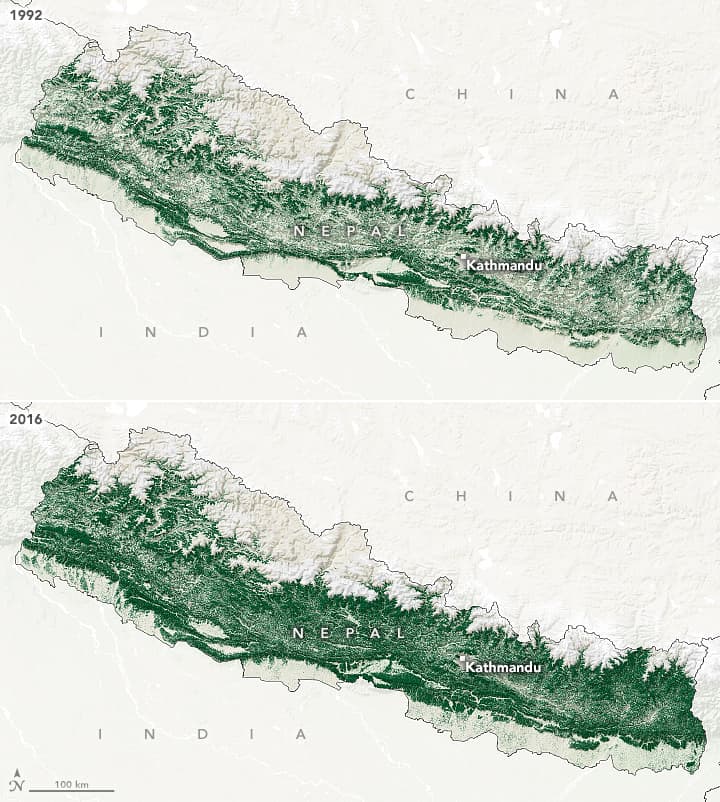
Forests are an important part of most countries’ environment. For Nepal, a country that lies at an average elevation of 3265 m above sea level, forests are especially important. But by the 1970s, Nepal was facing a huge forest crisis
Nepal contains most of the Himalayas, the highest mountain range in the world, and much of Nepalese society is heavily entwined with nature. But livestock grazing and fuelwood harvesting led to massive deforestation.
Forests in Nepal were in trouble. Hillside forests were particularly degraded, prompting a 1979 World Bank report that warned that without major reform, forests in the country’s hills would be largely gone by 1990. Because the country’s geology is so special, Nepal also felt the disappearance of its forests. The destruction and degradation of hillside forests led to increased flooding and landslides.
So the country’s government took a big decision: it decided to take a step back.
The government reassessed its forest management policy, gradually ceding more control to local communities. Then, in 1993, a pivotal act enabled the forest rangers to give control to local community forest groups. This turned out to be a major decision.
Now, a few decades years later, NASA-funded research has found that decision paid dividends big time. Over a third of Nepal’s forest cover is community-managed, and forest cover in the country almost doubled, from 26% to 45%. Independent studies also confirmed the major reforestation progress Nepal has made.
“Once communities started actively managing the forests, they grew back mainly as a result of natural regeneration,” said Jefferson Fox, the principal investigator of the NASA Land Cover Land Use Change project and Deputy Director of Research at the East-West Center in Hawaii. Before Nepal passed the 1993 forestry act, government management of forests was less active. “People were still using the forests,” Fox added, “they just weren’t allowed to actively manage them, and there was no incentive to do so.” As a result, the forests were heavily grazed by livestock and picked over for firewood. They became degraded.
The improvement happened gradually. For instance, in one particular community forest, called Devithan (or “sacred grove”), the community forest had only 12% forest cover in 1988. Initially, the local community wasn’t formally involved in forest management. After the 1993 act, they organized an informal group, attempting to get involved in every way they could. Already, this led to a big improvement. By 2000, they were recognized as a formal group. By 2016, the forest cover had grown 92% (from 16%). A quarter of this improvement happened when the community was only organized as an informal group.

The local environment is also rejoicing from this improvement. Natural parks, which contain several endemic and endangered species, are thriving once again. Rare species are enjoying new-found habitats and the proverbial “nature is healing” process is unfolding in Nepal.
For local communities, who rely on forests for much of their activity, this has brought new benefits, but also some new challenges. Nepal is one of the poorest countries in South Asia, and rural agriculture still accounts for a great deal of its economy. Landslides and floods have subsided, but as people live closer to wild animal habitats, accidents — and even fatalities — are becoming an issue in some parts of the country.
But the government now hopes that the forests could provide dividends in a new way. Richer countries are offering financial packages to motivate Nepal in its forest conservation work, as a part of their climate efforts. For instance, Nepal is expecting a $7.4 billion package from the British government and a $300 million package from Norway and the US.
But sustaining this fragile recovery isn’t easy. As is the case elsewhere in the world (especially in the Amazon), defending the forests isn’t easy. Community managers often have to double down as rangers, guarding their forests against poachers and the timber mafia. Often, the conflicts are violent. In the Chitwan National Park, more than 8,000 armed troops guard the wildlife reserve, but other areas are not as fortunate.
No doubt, Nepal’s recovery is exemplary — there’s definitely a lot to learn from it. Enabling local communities and indigenous groups to manage their local forests seems to pay dividends, but will this recovery be sustained? It’s tough to achieve progress, but it’s easy to lose it. Hopefully, for Nepal and for the rest of the world, this will turn out to be a sustainable recipe for success.









